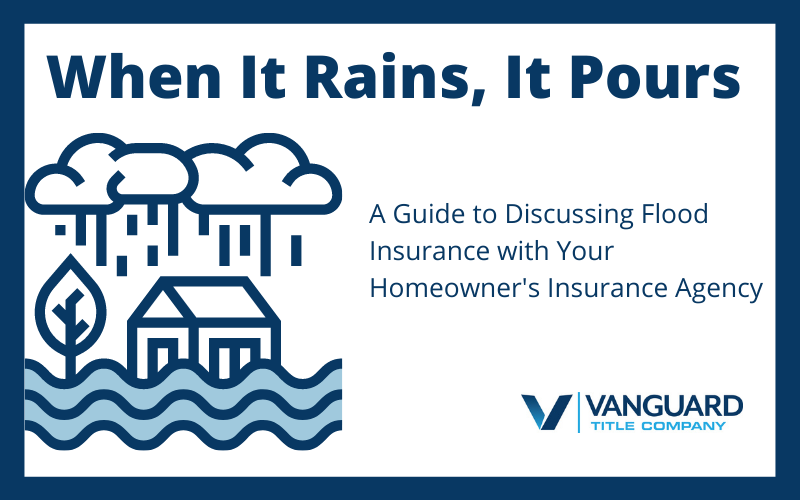By Christina Kass
When it comes to protecting your new home, you may be confident your homeowner’s insurance will cover whatever disaster may come your way. However, it’s a common misconception that homeowner’s policies cover damage from the No. 1 natural disaster in the U.S. — floods.
Although flooding may not be among your top concerns as a homebuyer, it’s important to remember that a flood can happen anywhere, at any time. And, the cost can be devastating. According to The Federal Emergency Management Agency (FEMA), just one inch of water in your home can cost more than $20,000 in damage!
Purchasing flood insurance can be the best way to prevent devastation to your home and finances in the event of a flood. Still, you may wonder whether or not you actually need flood insurance, especially if you live in an area that is not prone to flooding. Read on to learn more about this often-misunderstood type of protection.
Understand Your Home’s Flood Risk
Even if your home isn’t located near a body of water, it may still be vulnerable to flood damage from heavy rains or spring thaws. To determine your home’s risk of flooding, you can use FEMA’s free flood risk mapping service. Simply type in your address to learn about flood zones, floodways, and your home’s risk level.
If you live in a high-risk flood zone, your mortgage lender may require you to buy flood insurance. However, if you live in a moderate- to low-risk zone, and your community belongs to the National Flood Insurance Program (NFIP), you may have the option of buying it.
You may be surprised to learn that, according to FEMA, more than 20 percent of NFIP claims are from outside of high-risk flood areas. Plus, people who are not in high-risk zones receive one-third of federal disaster assistance for flooding. That’s why purchasing flood insurance is highly recommended, regardless of your flood risk.
Determine What Type of Flood Insurance You Need
The area in which you live helps to determine which type of flood insurance is best for you. Federally backed NFIP flood insurance offered through FEMA is available to homeowners in more than 22,000 participating communities. In addition, private flood insurance is offered by participating companies, with varying options and premiums. Both NFIP and private insurance are purchased through an insurance agent or company.
An NFIP policy may be purchased at any time, as long as your community participates in the program — and most do. The NFIP’s Preferred Risk Policy is designed to be affordable, with a premium for a primary residence costing about $467 a year for $200,000 of coverage for a home structure and $80,000 for contents. That’s a drop in the bucket compared to the potential cost of flood damage.
Keep in mind: There’s typically a 30-day waiting period before the policy goes into effect, with some exceptions, so planning ahead is important. Also, most flood policies do not cover losses caused by a flood that occurred prior to the policy becoming effective, and you usually cannot increase your coverage once a flood has begun.
Know Exactly What Flood Insurance Covers
In the event of a flood, your insurance policy traditionally covers direct physical losses to your structure and belongings (building coverage and contents coverage). With an NFIP policy, a maximum of $250,000 of building coverage is available for single-family residential buildings, and $250,000 per unit for residential condominiums.
The limit for contents coverage on all residential buildings is $100,000. Commercial structures can be insured to a limit of $500,000 for the building and $500,000 for the contents. Private flood insurers can provide much higher limits.
Items typically protected under building coverage include:
- Electrical and plumbing systems
- Furnaces and water heaters
- Refrigerators, cooking stoves, and built-in appliances like dishwashers
- Permanently installed carpeting
- Permanently installed cabinets, paneling, and bookcases
- Window blinds
- Foundation walls, anchorage systems, and staircases.
- Detached garages
- Fuel tanks, well water tanks and pumps, and solar energy equipment
Items typically covered under contents coverage include:
- Personal belongings, such as clothing, furniture, and electronics
- Curtains
- Washer and dryer
- Portable and window air conditioners
- Microwave oven
- Carpets not included in building coverage
- Valuable items, such as original artwork
It’s also helpful to know what may not be covered under flood insurance. FEMA’s definition of a flood is “an excess of water on land that is normally dry, affecting two or more acres of land or two or more properties.” Therefore, if a sewer backup occurs and the incident is not caused directly by flooding, the damage would most likely not be covered. The cause of flooding is usually the main criterion in determining the coverage.
Turn To Vanguard for Help Protecting Your Property
At Vanguard Title, we know life can be unpredictable and floods can happen anywhere. We recommend that you contact your homeowner’s insurance provider and ask them to review your flood insurance options. Your lender may also be able to recommend reputable flood insurance agencies. Many property owners don’t find out until it’s too late that their homeowner’s policy doesn’t cover flooding. No matter what your risk level, flood insurance may be necessary — because if it can rain, it can flood.

